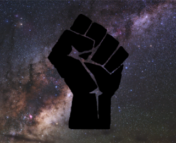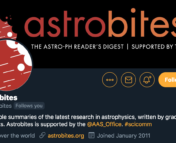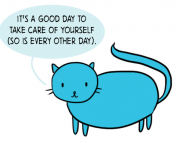Anyone who has seen an image from Hubble knows that space is downright beautiful. It’s almost no surprise that the wonders of the cosmos have inspired art and culture for much of humanity’s history. Science art is both valuable for and created by scientists, science communicators, and really anyone with any interest in space. In today’s Beyond Bite, we’ll look at the role and importance of science art in modern astronomy, as well as hear from many science artists about what motivates them to create.
The Value of Science Art
Science is inherently creative
Although science is often thought of as separate from and more objective than art, people are finally breaking down that idea. Science is done by people, for people, and inherently includes all the complexity that comes along with that. Science also requires a great deal of creative thinking, a fact that is integral to the popular STEAM (Science, Technology, Engineering, Arts, and Math) framework of education. This educational strategy incorporates both arts and science into a holistic education, building students’ critical thinking, problem solving skills, and creativity.
Visual art also comes into play in part of the scientific process: data visualization. Designing engaging, understandable, and appealing plots is akin to a creative art practice, and there are even contests for the best plot art, such as the John Hunter Excellence in Plotting Contest. Sometimes, the mistakes of data visualization create abstract art on their own, too, as displayed in @accidental_art.
Art bolsters wellbeing
From art therapy to adult coloring books, there is ample evidence of the benefits of practicing art on peoples’ mental health and overall wellbeing. Science, on the other hand, has a history of being hard on mental health (especially in graduate school!) and encouraging poor work-life balance. Research has shown that having hobbies, such as creative and artistic pursuits, can lower stress levels and improve people’s sense of work-life balance. Although hobbies and art certainly have value outside of their use in science, they can also help scientists find new creative inspiration to solve problems and even improve their productivity in the long run. Scientists can also share their hobbies and art as part of their science communication, breaking down harmful stereotypes and even boosting their credibility and effectiveness in connecting with various public audiences.
Science communication through art
One of the most often cited reasons for making science art is that it helps share science in a fun way that engages broad audiences. Only a fraction of the science being done makes it to the public, partially due to the fact that many audiences harbor mistrust of scientists or are simply unfamiliar with scientific thinking and methods. Another problem is the widely used “deficit model” of science communication, in which people need to simply be given objective information to change their views and learn.
Instead of seeing emotionality as simply a barrier to objectivity, we can harness emotion to engage audiences and build trust, often through art. Art can open the door to a different model of communication—two-way engagement, in which people actively ask questions and participate in understanding scientific discovery. Nature has even recently extolled the virtues of artist-scientist collaborations, describing the results as “exhilarating, challenging, enlightening, stimulating, inspiring, fun.”
A 2016 study of science communication found that art is increasingly being incorporated into science communication and outreach efforts through artist residencies, classes, exhibitions, and more, although physical science lags behind other disciplines in its use of science art. Dedicated science art galleries and events are also growing, such as the The Art of Planetary Sciences show at the AAS Division for Planetary Sciences yearly meeting and the STARtorialist booth at the AAS bi-annual meetings. Some institutions, such as Caltech, also have art installations within their academic buildings.
Stories from Science Artists
Although research has looked into the value of scientific art, it’s impossible to truly understand the impacts and motivations to make astronomical art without actually talking with the people involved. Below are quotes from many different science artists, describing their “why” for creating art based on outer space or telling stories about ways science art has enriched their lives, careers, and more.
“I’m pretty into space cross stitch…I realized the pulsar plot profile would work perfectly, and it turned out awesome so I made a second when Jocelyn [Bell Burnell] visited our department for her! The pulsar plot profile I made her is of the first pulsar she discovered. Think I reached my peak nerd in that pic of the two of us for sure. She loved it!” — Dr. Yvette Cendes @whereisyvette [Images below courtesy of Dr. Yvette Cendes]


“I make my little astronauts because they remind me to explore in wonder, to appreciate having a breathable atmosphere, and to remember what we can do when we collectively aim ourselves at a goal!” — XXYXXYART @xxyxxyart
“I think it’s very important for artists to make the huge universe something that everyone can relate to and enjoy in tangible ways.” — Yugen Tribe @yugentribe
“There are a lot of cool images in the Hubble archive that don’t make it out to the public in a meaningful way, so I try to find those and bring them out. Other than that, it’s a fun way to explore and begin to understand astronomy and astronomers.” — Judy Schmidt @SpaceGeck
“Space is vastly interesting…I usually am inspired by whatever I am learning about as my amateur astronomer/space lover self. Oppy up there [in the image] was in order to keep busy while I was worried about the dust storm. New Horizons was designed just after flyby, and I worked on Juno while watching it arrive at Jupiter.” — Alyshondra Meacham @AlyshondraM

“I do a lot of sci art because I want people to appreciate the things I study in a way where they might not normally see them…I think also a big thing for me too is I love defying expectations, and I’m so tired of seeing scientists depicted in such one-dimensional ways…we have other passions, especially in the arts, and I think the two go hand-in-hand. I think being solely invested in a singular science is not sustainable and is more susceptible to burnout.” — Marina Dunn @Astro__Marina
“I’ve tried my hand at some astro artwork as part of our #AstroOnTap LA [outreach] posters (for Caltech Astro)…it’s nice to take a break from science to work on these. They’re a labor of love.” — Cameron Hummels @astrochum [Images below courtesy of Cameron Hummels / Caltech Astronomy on Tap]



“In a nutshell, I find it hard to communicate ideas verbally. I’m very socially anxious, too, but I appreciate that science communication is extremely important. This [art] was my attempt of using the knowledge and toolset I have to communicate science and my research.” — Soheb Mandai @TheAstroPhoenix
“I just recently became a science artist…When COVID took over and we self-isolated, I knew the only way I’d be able to get through it would be creativity and connections. I sent out over 300 postcards (mostly astronomy and famous women in science) all over the world. Then someone said I should make my own postcards…I began making Afronaut Space Art postcards that I send out to my patrons once a month. I love it. I never imagined I could be a space artist and now here I am doing it.” — Astronaut Dr. Sian Proctor @DrSianProctor
“I do #sciart for three reasons: 1) When the universe is trying to kill you, sometimes you just need to find zen in the art of planetary sciences. 2) Not all news stories have good art to go with them and I fill gaps. 3) The income makes a difference.” — Dr. Pamela L. Gay @starstryder


“10 years ago I needed an illustration for a book I wrote on astronomy in national parks. That illustration was so popular with park rangers it launched a career that eventually let me retire as a professor to pursue science outreach through art full time.” — Tyler Nordgren @NightSkyPark [Images above courtesy of Tyler Nordgren]
“Creating sci art gives me another way to communicate science to the public. As an astrophysicist, I’m passionate about science, but it’s nice to be able to take a visual approach. I enjoy making distant phenomena more tangible through a painting, like an exoplanet landscape of clouds on a brown dwarf.” — Dr. Laci Brock @stellerarts
“I’ve always had an interest in science fiction pop culture, mostly inspired by stories of lone astronauts bravely fighting against the unknown. They hit close to home a few years back, when my dad was dying from cancer and it felt like everyday I was facing new, intimidating worlds. A lot of my work at that time shows small astronauts alone on fracturing moons. But despite all that threatens them, they stand and face the uncertainty. The setting of space is a great backdrop for stories about confronting change bravely and to express empathy for people whose experiences and struggles seem so distant from our own.” — Amy Hill @amyraehill
Astronomical art illustrates the importance of creativity in science, and has a number of benefits to both its creators and viewers, enriching lives, creating community, and more. Art can help us share science in new and engaging ways, and together with art we can gain a deeper appreciation of our place in this vast universe.
Edited by Luna Zagorac
Featured image courtesy of Dr. Yvette Cendes
Thank you again to everyone who shared their experiences and stories with science art for this Bite! If you’re on the lookout for more science artists, check out this list of science artists, curated by the SETI Institute.





Thank you for putting together astrophysics and art in a meaningful way for non-astronomers. These examples are illustration art, art intended to explain. It might be a worthy adventure to consider astrophysics images as true fine art, art that doesn’t exist to make a point but rather to inspire awe or a feeling for the sublime. I suggest the best place to find that kind of image lies outside the optical spectrum in the X-ray, UV, far IR, mm, and microwave bands. We see so many variations of optical-band images they tend to become forgettable. But the same objects seen in X-ray or sub-mm bands (ALMA, MeerKAT, even HESS gamma), are so exotically different they fall into the realm of the sublime: able to stop us in our tracks to simply admire or be provoked into similarly enlarging other aspects of our thinking. I look at the CMB the way I look at Jackson Pollock, and MeerKat images of magnetic spicules the way I look at abstract minimalism. The current crop of Illustris/TMB 50 Mpc video simulations are like watching abstract expressionism come to life and paint the canvas themselves. But that’s not a canvas, it’s a 50 Mpc pool of moving colour fields some 200 Kpc thick. Sim art is fine art in disguise and cannot be found in any traditional art book. Briley, your ideas are wonderful, can you expand your horizons a bit, say, 100 Mpc over 500 Myr? You might start with .
Briley, the link that was dropped in the previous post is .
Back in 2018, during the first year of my PhD in astronomy, a chance meeting with a couple of artists led me to take up painting as a creative outlet for all the nervous stress of grad student life. I don’t have much formal art training, but growing up it was the artist’s impressions of astronomical objects, even more than the pretty pictures of galaxies and nebulae, that inspired me to pursue astronomy. I think subconsciously I always wanted to be the person making such images, and painting has allowed me to do that; I’ve done several of astronomical subjects, with some of my favorites being a seven-panel series of the spectral classes of main-sequence stars (to scale with each other) and a pair of binary black holes with (semi-)realistic gravitational light-bending of their accretion disks based off of simulations. Going forward I hope to be able to use my art skills in outreach to help people experience the same wonder I feel when studying the universe.